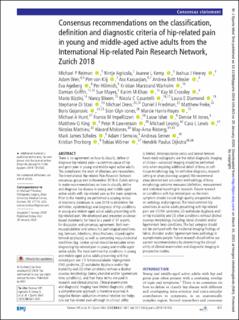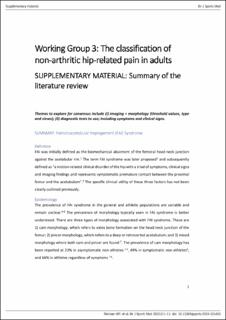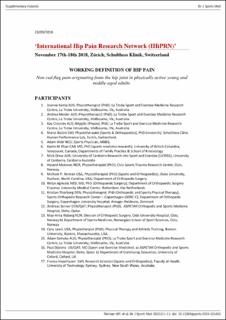| dc.contributor.author | Reiman, Michael P. | |
| dc.contributor.author | Agricola, Rintje | |
| dc.contributor.author | Kemp, Joanne L. | |
| dc.contributor.author | Heerey, Joshua J. | |
| dc.contributor.author | Weir, Adam | |
| dc.contributor.author | van Klij, Pim | |
| dc.contributor.author | Kassarjian, Ara | |
| dc.contributor.author | Mosler, Andrea Britt | |
| dc.contributor.author | Ageberg, Eva | |
| dc.contributor.author | Hölmich, Per | |
| dc.contributor.author | Warholm, Kristian Marstrand | |
| dc.contributor.author | Griffin, Damian | |
| dc.contributor.author | Mayes, Sue | |
| dc.contributor.author | Khan, Karim | |
| dc.contributor.author | Crossley, Kay M. | |
| dc.contributor.author | Bizzini, Mario | |
| dc.contributor.author | Bloom, Nancy | |
| dc.contributor.author | Casartelli, Nicola C. | |
| dc.contributor.author | Diamond, Laura E. | |
| dc.contributor.author | Di Stasi, Stephanie | |
| dc.contributor.author | Drew, Michael | |
| dc.contributor.author | Friedman, Daniel J. | |
| dc.contributor.author | Freke, Matthew | |
| dc.contributor.author | Gojanovic, Boris | |
| dc.contributor.author | Glyn-Jones, Sion | |
| dc.contributor.author | Harris-Hayes, Marcie | |
| dc.contributor.author | Hunt, Michael A. | |
| dc.contributor.author | Impellizzeri, Franco M. | |
| dc.contributor.author | Ishøi, Lasse | |
| dc.contributor.author | Jones, Denise M. | |
| dc.contributor.author | King, Matthew G. | |
| dc.contributor.author | Lawrenson, Peter R. | |
| dc.contributor.author | Leunig, Michael | |
| dc.contributor.author | Lewis, Cara L. | |
| dc.contributor.author | Mathieu, Nicolas | |
| dc.contributor.author | Moksnes, Håvard | |
| dc.contributor.author | Risberg, May Arna | |
| dc.contributor.author | Scholes, Mark James | |
| dc.contributor.author | Semciw, Adam I. | |
| dc.contributor.author | Serner, Andreas | |
| dc.contributor.author | Thorborg, Kristian | |
| dc.contributor.author | Wörner, Tobias | |
| dc.contributor.author | Dijkstra, Hendrik Paulus | |
| dc.date.accessioned | 2021-03-20T08:49:38Z | |
| dc.date.available | 2021-03-20T08:49:38Z | |
| dc.date.created | 2020-05-03T13:33:53Z | |
| dc.date.issued | 2020 | |
| dc.identifier.citation | British Journal of Sports Medicine. 2020, 54(11), 631–641. | en_US |
| dc.identifier.issn | 0306-3674 | |
| dc.identifier.uri | https://hdl.handle.net/11250/2734592 | |
| dc.description | Free BMJ article. No commercial re-use. | en_US |
| dc.description.abstract | There is no agreement on how to classify, define or diagnose hip-related pain—a common cause of hip and groin pain in young and middle-aged active adults. This complicates the work of clinicians and researchers. The International Hip-related Pain Research Network consensus group met in November 2018 in Zurich aiming to make recommendations on how to classify, define and diagnose hip disease in young and middle-aged active adults with hip-related pain as the main symptom. Prior to the meeting we performed a scoping review of electronic databases in June 2018 to determine the definition, epidemiology and diagnosis of hip conditions in young and middle-aged active adults presenting with hip-related pain. We developed and presented evidence-based statements for these to a panel of 37 experts for discussion and consensus agreement. Both non-musculoskeletal and serious hip pathological conditions (eg, tumours, infections, stress fractures, slipped capital femoral epiphysis), as well as competing musculoskeletal conditions (eg, lumbar spine) should be excluded when diagnosing hip-related pain in young and middle-aged active adults. The most common hip conditions in young and middle-aged active adults presenting with hip-related pain are: (1) femoroacetabular impingement (FAI) syndrome, (2) acetabular dysplasia and/or hip instability and (3) other conditions without a distinct osseous morphology (labral, chondral and/or ligamentum teres conditions), and that these terms are used in research and clinical practice. Clinical examination and diagnostic imaging have limited diagnostic utility; a comprehensive approach is therefore essential. A negative flexion–adduction–internal rotation test helps rule out hip-related pain although its clinical utility is limited. Anteroposterior pelvis and lateral femoral head–neck radiographs are the initial diagnostic imaging of choice—advanced imaging should be performed only when requiring additional detail of bony or soft-tissue morphology (eg, for definitive diagnosis, research setting or when planning surgery). We recommend clear, detailed and consistent methodology of bony morphology outcome measures (definition, measurement and statistical reporting) in research. Future research on conditions with hip-related pain as the main symptom should include high-quality prospective studies on aetiology and prognosis. The most common hip conditions in active adults presenting with hip-related pain are: (1) FAI syndrome, (2) acetabular dysplasia and/or hip instability and (3) other conditions without distinct osseous morphology including labral, chondral and/or ligamentum teres conditions. The last category should not be confused with the incidental imaging findings of labral, chondral and/or ligamentum teres pathology in asymptomatic people. Future research should refine our current recommendations by determining the clinical utility of clinical examination and diagnostic imaging in prospective studies. | en_US |
| dc.language.iso | eng | en_US |
| dc.subject | consensus | en_US |
| dc.subject | examination | en_US |
| dc.subject | hip | en_US |
| dc.title | Consensus recommendations on the classification, definition and diagnostic criteria of hip-related pain in young and middle-aged active adults from the International Hip-related Pain Research Network, Zurich 2018 | en_US |
| dc.type | Peer reviewed | en_US |
| dc.type | Journal article | en_US |
| dc.description.version | publishedVersion | en_US |
| dc.rights.holder | © Author(s) (or their employer(s)) 2020 | en_US |
| dc.source.pagenumber | 631-641 | en_US |
| dc.source.volume | 54 | en_US |
| dc.source.journal | British Journal of Sports Medicine | en_US |
| dc.source.issue | 11 | en_US |
| dc.identifier.doi | 10.1136/bjsports-2019-101453 | |
| dc.identifier.cristin | 1809112 | |
| dc.description.localcode | Institutt for idrettsmedisinske fag / Department of Sports Medicine | en_US |
| cristin.ispublished | true | |
| cristin.fulltext | original | |
| cristin.qualitycode | 2 | |


